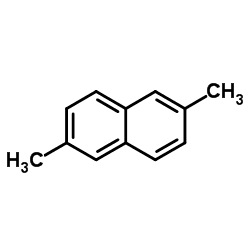Formula C12H12 | ||
 | ||
2,6-Dimethylnaphthalene (2,6-DMN) is a polycyclic aromatic hydrocarbon. It is one of the many possible dimethylnaphthalene isomers which are derived from naphthalene by the addition of two methyl groups. 2,6-DMN is of commercial importance as a starting material for high-performance polyester fibers and films. Polyethylene naphthalate (PEN) is made using the oxidation product of 2,6- DMN.
Contents
Synthesis
Alkylated naphthalenes (methyl-, dimethyl-, and poly-methyl naphthalenes, thus including 2,6-DMN) are found in low concentrations in crude oil and coal tar. Separation is difficult, expensive, and requires a number of operations such as selective crystallization and adsorption, in addition to any isomerization reactions. There has been a search for suitable synthetic routes to 2,6-DMN.
In the "alkenylation process" butadiene (1) and o-xylene (2) are used, which react to form 5-(orthotolyl)pent-2-ene (OTP, 3). OTP is subsequently cyclized to 1,5-dimethyltetraline (4). Dehydrogenation then provides 1,5-dimethylnaphthalene (1,5-DMN, 5). Finally, 1,5-DMN is isomerized to 2,6-DMN (6). In the final step, other mono-, di-, and tri-ethylnaphthalenes are formed. More work is therefore required in separation of the mixture, which is done by selective crystallization.
Applications
2,6-Dimethylnaphthalene is mainly used for the preparation of 2,6-naphthalenedicarboxylic acid by oxidation of 2,6-dimethylnaphthalene in the liquid phase. 2,6-Naphthalenedicarboxylic acid is a monomer for the production of high-performance polymers, in particular poly (ethylene-2,6-naphthalene dicarboxylate) or shorter polyethylene naphthalate (PEN), a polyester which is stronger and has a higher thermal resistance than the frequently used polyethylene terephthalate (PET). However, 2,6-DMN is a more expensive intermediate than terephthalic acid that is used for PET.
